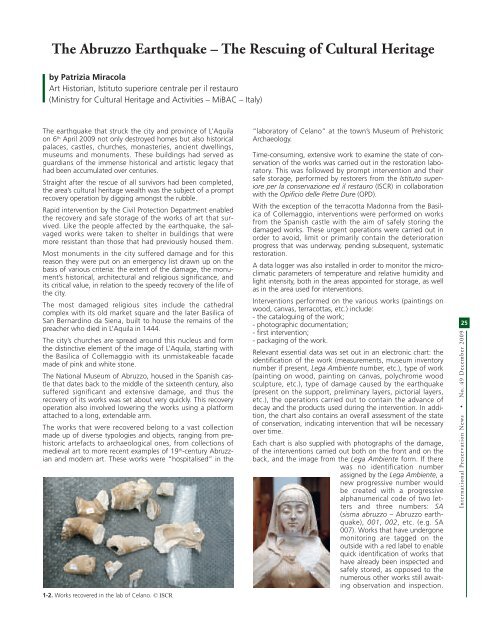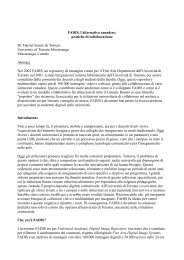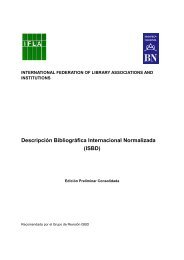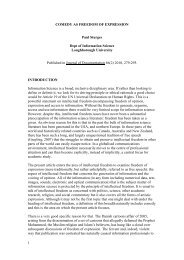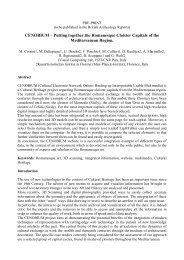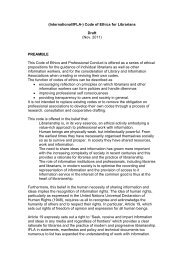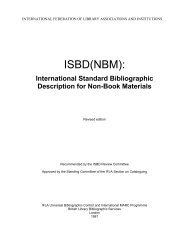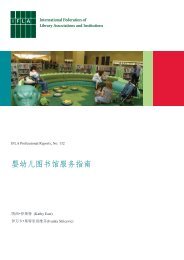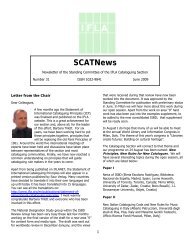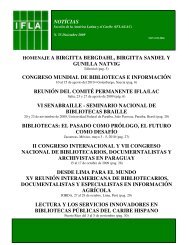No 49 - IFLA
No 49 - IFLA
No 49 - IFLA
You also want an ePaper? Increase the reach of your titles
YUMPU automatically turns print PDFs into web optimized ePapers that Google loves.
The Abruzzo Earthquake – The Rescuing of Cultural Heritage<br />
by Patrizia Miracola<br />
Art Historian, Istituto superiore centrale per il restauro<br />
(Ministry for Cultural Heritage and Activities – MiBAC – Italy)<br />
The earthquake that struck the city and province of L’Aquila<br />
on 6th April 2009 not only destroyed homes but also historical<br />
palaces, castles, churches, monasteries, ancient dwellings,<br />
museums and monuments. These buildings had served as<br />
guardians of the immense historical and artistic legacy that<br />
had been accumulated over centuries.<br />
Straight after the rescue of all survivors had been completed,<br />
the area’s cultural heritage wealth was the subject of a prompt<br />
recovery operation by digging amongst the rubble.<br />
Rapid intervention by the Civil Protection Department enabled<br />
the recovery and safe storage of the works of art that survived.<br />
Like the people affected by the earthquake, the salvaged<br />
works were taken to shelter in buildings that were<br />
more resistant than those that had previously housed them.<br />
Most monuments in the city suffered damage and for this<br />
reason they were put on an emergency list drawn up on the<br />
basis of various criteria: the extent of the damage, the monument’s<br />
historical, architectural and religious significance, and<br />
its critical value, in relation to the speedy recovery of the life of<br />
the city.<br />
The most damaged religious sites include the cathedral<br />
complex with its old market square and the later Basilica of<br />
San Bernardino da Siena, built to house the remains of the<br />
preacher who died in L’Aquila in 1444.<br />
The city’s churches are spread around this nucleus and form<br />
the distinctive element of the image of L’Aquila, starting with<br />
the Basilica of Collemaggio with its unmistakeable facade<br />
made of pink and white stone.<br />
The National Museum of Abruzzo, housed in the Spanish castle<br />
that dates back to the middle of the sixteenth century, also<br />
suffered significant and extensive damage, and thus the<br />
recovery of its works was set about very quickly. This recovery<br />
operation also involved lowering the works using a platform<br />
attached to a long, extendable arm.<br />
The works that were recovered belong to a vast collection<br />
made up of diverse typologies and objects, ranging from prehistoric<br />
artefacts to archaeological ones, from collections of<br />
medieval art to more recent examples of 19th-century Abruzzian<br />
and modern art. These works were “hospitalised” in the<br />
1-2. Works recovered in the lab of Celano. © ISCR<br />
“laboratory of Celano” at the town’s Museum of Prehistoric<br />
Archaeology.<br />
Time-consuming, extensive work to examine the state of conser<br />
vation of the works was carried out in the restoration laboratory.<br />
This was followed by prompt intervention and their<br />
safe storage, performed by restorers from the Istituto superiore<br />
per la conservazione ed il restauro (ISCR) in collaboration<br />
with the Opificio delle Pietre Dure (OPD).<br />
With the exception of the terracotta Madonna from the Basilica<br />
of Collemaggio, interventions were performed on works<br />
from the Spanish castle with the aim of safely storing the<br />
damaged works. These urgent operations were carried out in<br />
order to avoid, limit or primarily contain the deterioration<br />
progress that was underway, pending subsequent, systematic<br />
restoration.<br />
A data logger was also installed in order to monitor the microclimatic<br />
parameters of temperature and relative humidity and<br />
light intensity, both in the areas appointed for storage, as well<br />
as in the area used for interventions.<br />
Interventions performed on the various works (paintings on<br />
wood, canvas, terracottas, etc.) include:<br />
- the cataloguing of the work;<br />
- photographic documentation;<br />
- first intervention;<br />
- packaging of the work.<br />
Relevant essential data was set out in an electronic chart: the<br />
identification of the work (measurements, museum inventory<br />
number if present, Lega Ambiente number, etc.), type of work<br />
(painting on wood, painting on canvas, polychrome wood<br />
sculpture, etc.), type of damage caused by the earthquake<br />
(present on the support, preliminary layers, pictorial layers,<br />
etc.), the operations carried out to contain the advance of<br />
decay and the products used during the intervention. In addition,<br />
the chart also contains an overall assessment of the state<br />
of conservation, indicating intervention that will be necessary<br />
over time.<br />
Each chart is also supplied with photographs of the damage,<br />
of the interventions carried out both on the front and on the<br />
back, and the image from the Lega Ambiente form. If there<br />
was no identification number<br />
assigned by the Lega Ambiente, a<br />
new progressive number would<br />
be created with a progressive<br />
alphanumerical code of two letters<br />
and three numbers: SA<br />
(sisma abruzzo – Abruzzo earthquake),<br />
001, 002, etc. (e.g. SA<br />
007). Works that have undergone<br />
monitoring are tagged on the<br />
outside with a red label to enable<br />
quick identification of works that<br />
have already been inspected and<br />
safely stored, as opposed to the<br />
numerous other works still awaiting<br />
observation and inspection.<br />
25<br />
International Preservation News <strong>No</strong>. <strong>49</strong> December 2009


